First Time Renting or Buying
Arizona Resort Park Models
The Arizona RV Resort Park
Experience
There are few places that offer the winter climate available in
Arizona. The desert location provides winter weather that is
conducive to outdoor life.
Relatives of ours used to spend three months each winter in a
Phoenix area park. Family would comment on their return that they
always looked healthier in April than any other time of the
year.
Our first experience in a trailer park was amazing and
surprising.
I have never seen so many older people golfing, playing tennis,
shuffleboard, in a swimming pool, and generally out-and-about.
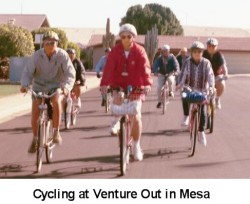
A common mode of transportation in the parks is bicycles. Almost
everyone has one and I had to get back on as well. (No you never
forget but those seats do seem a little harder than I remember)
The biggest surprise was probably the weather and lack of
bugs. I had always imagined winter in Arizona like (say) May at
home. Some nice sunny days, some calm days, some rainy days, some
cloudy days, some windy days, and such.
I was pleasantly surprised that maybe 90% of the days in February
were sunny and calm. Most days in February were around
20-25C (or 70-75F) with little if any breeze.
And the bugs. I never thought that critters would also hibernate in
warm climates, but they do. During a six week period I saw exactly two
bugs. I never realized before how pleasant it can be to have nice
summer days outdoors without bug spray or swatting the critters
off the food. It is quite pleasant.
What you Need to Know!
If you
haven't spent a winter in Arizona before
There are a lot of people who are looking for a way to spend their
winters in a climate more conducive to an active and enjoyable
lifestyle.
The problem is that if you have not experienced any of the various
options for that lifestyle it can be difficult to decide what to
pursue.
There are a few things you need to consider before you
decide whether the RV Resort Parks and a Park Model are for you.
Take the time to read about the lifestyle and experience,
the parks, the trailers, the weather, and ...
Don't think of it as a Trailer!
A strange statement to make on a site that is all about trailers.
But it is important to realize that, while called trailers, you will
probably feel more like you are in a cottage in a resort rather
than in a trailer in some 'old style' trailer park.
We have had some complaints about our name and
the use of the word 'trailer'. "They are called Park Models ... not
trailers!" we are told. We can understand the concern. It certainly
can be. But those who are looking at this lifestyle for the first time
tend to look for a 'trailer'. (And they are a park model of the
'trailer' family.)
You are not only in a resort you are in a 'community'. And a
community that really does have some of that 'small town America'
feel.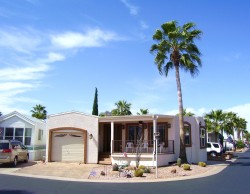
The park models are set up in a way that looks and
feels very permanent, and really almost is. The driveway,
patio, storage shed, and maybe an Arizona Room and even small garden
area all add to the feeling of a more permanent residence.
Many of the facilities in your home are also available in
the park models but some of it is outside or down the
street. As described in the section About Park Models. Y
our living space really extends to the outside and beyond.
The pool and hot tub are down the street instead of in the backyard.
The craft area, woodworking shop, laundry, music room, and other
facilities are there for your use but just not in your house or yard.
About the RV Resort Parks
Important - Resident-Owned vs Privately Owned
Parks
Before doing any park shopping make sure you
understand the differences, advantages, and disadvantages of choosing
a park that is resident-owned or one that is privately owned. (see the
section on private vs resident- owned
parks)
RV Resort Parks for the 55+
The whole focus of this site is the experience of living in a
Seniors RV Resort Park in a warmer climate through the winter
months.
There are literally hundreds of these parks in the state of Arizona
offering a wide array of amenities and lifestyle experiences. But
there are also some important differences.
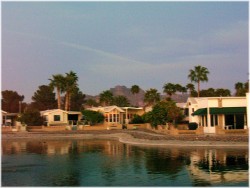
The size of the park is a primary determining factor. The
parks range considerably in size from the very smallest of maybe
25 unit lots to parks with 2,000 spaces.
It doesn't mean there is anything wrong with a smaller park but
naturally the larger parks can afford more activities, amenities, and
central facilities.
The medium and larger sized parks are pretty standard in terms of
layout, security, and central facilities. Some smaller parks are more
for the very budget conscious and those who are not interested in
paying for a lot of things they don't use. It is all about
individual choice.
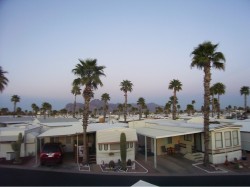
Most of the parks are about 70-90% 'park model' homes. (With
the rest being mostly motor homes and travel trailers.)
These park models are all about the same size. The lots they sit on
are about the same size.
Most parks separate the 'pets allowed' area from the 'no pet' area.
That 'Small Town America' Feel
We all know that model small town doesn't really exist outside of
Hollywood. But these parks have come about as close to that imaginary
feeling as I have seen.
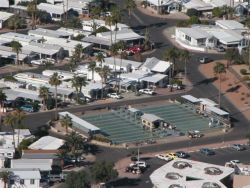
The clean paved streets with mostly bicycle and pedestrian activity
combined with the friendly greetings present a very comfortable
atmosphere.
Nearly all the parks are designed with a similar layout. Streets
of units surrounding central facilities.
And they are truly 'communities' onto themselves. There is a
strong community feeling in most of the parks as people live together
in a type of small town atmosphere. Everyone is very friendly and
quick to help a neighbor.
"We knew about these parks and
had considered trying it out to see if we liked that experience. I was
quite reluctant because I didn't feel quite ready for 'what I
perceived to be' the lifestyle. To my surprise I felt quite at home
and very comfortable. And my privacy was very well in hand. Sure
everyone is friendly and says 'hello' but no pressure to join or
participate. Or, lots to participate in if that is what you want. And
I was shocked that I actually enjoyed living in a 'trailer'. Never
thought that would happen."
It's interesting how all these people from all these different
places and backgrounds come together with the common bond of just
wanting to live life as enjoyable as possible. There is not a lot
of discussion about who you 'used to be'. Really not that many
actually care. Whether you were successful in your career or just
survived it doesn't really matter.
Status seeking is not very evident. It's like there no longer is
any value in trying to impress the neighbors.
Choosing a Park
"It may be hard to change later"
A major consideration when deciding to 'try out' a park is that you
may be choosing a new 'home town'.
It is noticeable how many park residents would find it unthinkable
(well almost) to move to a different park. It becomes a home
and it is sometimes hard to leave because you have become part of
a community.
Of course those with bad experiences will be happy to leave. But
once you develop a bit of a community social life it can be difficult
to start over again in another 'community'. You make friends and
develop relationships with neighbors. You get involved in group and
club activity and that can be hard to leave.
While some people have spent their lives moving to different
communities and don't worry about making new friends and such, many of
us get attached to our location and find a move more difficult. And,
to some, the older you are the less you search for the new adventure
associated with moving from your community.
- Choose carefully ... you may not want to change later.
Check out the Park Facilities, Services, Amenities, and
Activities
You should make sure you are moving to a park that has the
facilities, services, and the things to do that meet your needs and
interests.
Most of the larger parks have websites and we
have listed them in the parks listing and links sections. The parks do
a good job of listing their facilities and usually show pictures so
you can get an idea of what is available.
The park facilities include both the functional (laundry, office,
security, etc) and those related to park activities such as swimming
pools, hot tubs, workshops, and the like. And of course basic services
such as mail service, access to the internet and cable TV, as well as
maintenance and support.
- There are a huge assortment of facilities in some of the parks;
Recreation Centers, Exercise Rooms, Laundry, Swimming pools, Hot
Tubs, Libraries, Workshops, Card Rooms, Tennis Courts, Computer Rooms,
and on and on. Very large parks will even have Grocery Stores,
Restaurants, Driving Ranges/Putting Greens, and maybe a Golf Course.
You want to know that the facilities are in good condition and
things work as they are intended. You also want to know that the park
is clean and well maintained.
The Activities - "What is there to
do?"
That old clich� ... 'You can be as busy as you want to be'
... certainly fits the concept of the RV Resort trailer parks.
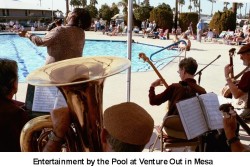
Tennis, Dancing, Golf, Billiards, Pickle ball, Concerts,
Shuffleboard, Horseshoes, Lapidary, Silversmithing, Wood Working,
Quilting, Card Games, Ping Pong, Ceramics and Pottery, Book Clubs,
Service Clubs, Church Services, Movies, Water Aerobics, Yoga, Pilates,
Painting, Computer Club, Choirs, Musical Groups, and more.
The last thing you need to worry about is having enough to do.
When choosing a park location the activities are critical if you
want to match your particular interests and lifestyle. If playing
horseshoes is your thing then look for horseshoe pits. If tennis is
your game then make sure there are adequate tennis courts. If you are
a 'lap swimmer' then make sure the pool(s) can accommodate that.
"We blew it on this one. We like
playing tennis and bought a park model in a park without
tennis courts. But thought it was such a good deal and we can drive to
tennis courts. Now we are sorry. But love the 'old' park
model and love the neighbors. Now what?"
While you may feel you can travel outside the park to participate
in activities (and certainly you can) you may not be so inclined once
you take up residence. It seems that park residents develop a
lifestyle that becomes more 'small town'. It becomes habit to walk to
things and/or ride your bike. You may strongly regret that you
chose a park where you needed to fire up the family vehicle and head
off into the city traffic to participate in your favorite activity.
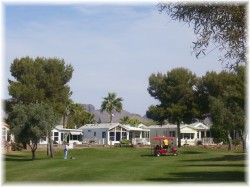
Of course some activities, like golfing, normally require outside
travel. But even with golf, there are some parks with (or bordering)
golf courses. Generally the larger the park more there is to choose
from. But it may not always be 'the more the better' for everyone.
It doesn't make much sense to contribute (and you usually will
either directly or indirectly) to an expensive recreation facility in
a park if you have absolutely no interest in that activity.
More about Park Activities
Most park sites will list at least the most common activities and
you should check out the list. If information is not shown or
your interests don't appear but other park attributes are appealing
then you may want to take the trouble to contact the park.
The parks have someone in charge of activities. This is often a
volunteer resident but could also be a park employee. Contact them
to discuss your interests. If their name and contact information
is not shown on the site then contact the park office. They are
usually more than anxious to accommodate and promote all they have to
offer.
In some cases the parks are hungry to have residents that like to
organize and spend their time getting people together for new
activities. If you are that type of person then you may be able to
start your own 'unique' activity. Ask if that is allowed and
supported.
Location - Location - Location
There are a lot of considerations regarding the location of the
park. Most of them are personal and depends on what appeals to
you and how you like to spend your time outside of the park.
The larger parks are really quite self-sufficient and you will
probably be surprised how little you travel out. But of course
you will want to shop, eat out, golf, and take in the whole array of
adventures and entertainment in the area.
Keep in mind that you are actually having to
consider TWO community locations. (1) The location of your trailer
within the park 'community' and (2) the location of your park
within the larger community.
Park Security
Check out the park security.
We all care about the safety and security of our homes. And of
course your winter home is just as important. This is even more
important to those of us who come from smaller or rural communities
into a strange place and maybe even find big cities a little scary.
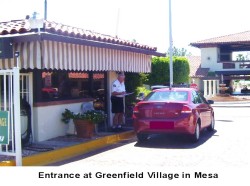 A huge huge advantage
of having a winter residence in the (larger) parks is the 24 hour
security. These parks are gated and most have a security person at
the gate checking who comes into the park.
A huge huge advantage
of having a winter residence in the (larger) parks is the 24 hour
security. These parks are gated and most have a security person at
the gate checking who comes into the park.
This is also important because you don't live here year-round. The
comfort of knowing there is an emphasis on security helps you to
relax and enjoy the lifestyle.
The Park 'Paper'
Many parks have regular (usually weekly) publications describing
park news, events and activities. Usually done by resident volunteers.
They are a good source of resident information but also provide a
bit of the 'flavor' of park life.
Getting a copy(s) of these journals can contribute to your
information package when deciding on a park location. Some parks place
the copies of the park paper on their websites. Worth checking.
Watch out for the Rules!
Before committing to residence
(especially if buying a trailer) make sure you get a copy of the park
rules and even take the trouble to (at least) phone the park office to
discuss arrangements and clarify rules of residence.
Rules are important and you should want the park to have them. But
within reason.
You should look for a park that has rules that you
appreciate if you are making it your (part-time) home. You will
want to feel some comfort in knowing that security and other aspects
are important to the park management. But you will also want to make
sure you do not lose your lifestyle independence with over-zealous
park management.
It is common for parks to have rules governing security,
cleanliness, quiet, and general good conduct. And most parks do an
excellent job of maintaining these standards.
If you are not moving into a 'resident owned' park then you will be
at the mercy of the park owners and management. They get to make the
rules and of course rules are important. But, some are more reasonable
than others.
"Our bad experience had to do
with renting out our park model. We felt we could rent it out for a
month or two when we were not using it. After considerable roadblocks
put up by the park management (i.e. need the renters credit report
with a high rating even though the renters were paying us) we had to
tell our renters that they could not come.
Our sense was that the park
management really didn't want to encourage residents renting out their
trailers. Whether that was an overzealous attempt in trying to
maintain more control over who was staying in the park or an attempt
to limit competition for the park owned rentals I am not sure."
Unless you invested in a
resident-owned park ... Remember that you are Parking
Your Park Model on a Rented Lot
There is a tendency to think you have bought a residence just like
buying a house back home. But you need to remember that you only
bought the trailer. And you parked that trailer in an RV park. It
may have already been parked there when you bought it but it is really
no different than when you rent a spot at a campground ... just a
much, much longer stay.
When you pay for the annual rent of the lot that is the only
timeframe you have agreement for. The park owner can refuse to rent it
to you the next year and then you have a problem. That may be rare but
it is legally possible.
The Importance of
Rules about Park Model Age
A park model is not a house. A park model is
legally a vehicle and is likely to depreciate rather
than appreciate.
Many parks have a rule on the age (and condition)
of park models being moved into their parks. And some
requirements regarding the upkeep of the units. It is very common that
parks will not allow a park model older than (say) ten years
to move into the park.* They of course want to maintain high
standards. This is understandable but also is an important issue to
consider when you buy a unit.
While you are just parking on a rented lot (with generally a one-
year term agreement) you also can't just move it to another park. If
you buy an older unit you are taking some added risk that you
need to consider. You are probably stuck with that unit in 'that'
park. You are quite limited in the choice of parks you can move to.
(Not to mention that the cost to move can be as high as the value of
an old park model.)
It is certainly rare that park operators refuse to renew rental
agreements because of unit age. But it has happened.
This doesn't mean to suggest that an older budget-
priced park model is a bad buy. In fact, it can be quite
the opposite. But you do need to view your purchase similar to
buying an old car compared to a new car. It will depreciate and it
will require some more work and maintenance. And when you are done
with it you may not recover your original price. An old car may have
to be sent to the wrecker when you are done with it. An old park
model could have the same fate ... probably not, but possible.
Rules regarding 'First Right of
Refusal'
Some parks will require that you do not sell your park
model (while parked on their lot) without offering the park owner
a first right of refusal. You come up with a buyer at a price and then
are required to inform the park operator of the deal. The park
operator may decide they want to buy it at that price ... and have
the right to do so as long as it is being parked in their park.
Rules
Limiting Park Model Ownership
Another rule that is worth knowing about.
Some parks will limit you to renting only one lot. What that
can mean is that you cannot buy that nice, newer, place next door and
then decide to rent out your older unit.
It can even mean that when you buy a different park
model in the park you need to immediately have yours sold or you
could end up breaking the rule of limitation to one rented lot.
Of course park operators will generally be reasonable but it can
also be a rule that hits you by surprise.
Planning to Buy a
'Fixer-Upper' and Rebuild it Yourself?
Many parks will have rules that do not allow you to do any major
renovation work yourself. If the work involves anything that
requires a municipal permit they may insist that you hire a licensed
contractor.
Of course most park model owners will do smaller jobs
themselves and that is not a problem, in fact it is probably
encouraged. But it is worth checking for these rules if you
have any plans to redo that older unit. It can be a real unhappy
surprise later on.
About Park Models
It is quite difficult to find good information on park
models. After a lot of searching we have located some sites
that provide information but even those tend to be more generally
about motor homes and/or recreational vehicles.
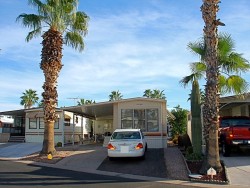
The average park model is really very inexpensive. (see:
how much will it
cost)
A basic new unit can be purchased for as
little
as 45,000 and up to over 100,000. Many used units on
'rented'
lots are available for anywhere from $5,000 and up. Most are priced in
the neighborhood of $15-75,000 and up. Can range higher with a lot of
extras.
In resident-owned parks the whole cost
changes because you are
now buying not
only the actual unit but also your share
in the park itself.
They are all about the Same Size
400 Square Feet
- But that
can be Misleading -
The park models all start out at about 400 square feet.
But then a storage room gets built and maybe an Arizona Room. There
are all kinds of creative modifications done to enhance the
living space. The climate allows for some pretty basic enclosures to
be added that functionally serve as an addition to living quarters.
But still generally retain the legal status as a vehicle.
Park models in Arizona cannot exceed 399 square feet if they
are to benefit from vehicle status and not be subject to residential
taxes.
We eventually learned why that is. It seems that there was a
municipal taxing issue of how to tax a park model if it is essentially
permanently parked on property. At what point is it a trailer (classed
as a vehicle) and at what point is it a permanent residence. It may
still even have wheels and can be moved.
It was decided to use square footage. Under 400 square feet
is a vehicle and legal ownership titles are handled
by motor
vehicles.
The diagram shown here is a very typical park
model design. This layout is very common, at least before any
modifications or additions.

A
standard layout consists of a
bedroom, bathroom, and open
design
Kitchen/Dining/Livingrooms.
The front door is typically
patio doors and the rear door opens to the patio or Arizona room. They
are well designed and make good use of the space available.
The common width is 12 feet so the length is normally
just over 30 feet. But there are still some that are narrower.
Some very old units are only 8 feet wide and tend to resemble a
standard older traveling trailer. Then additions were designed to
expand to a 12 foot width. That resulted in what is called 'slide
outs' or 'tip outs'.
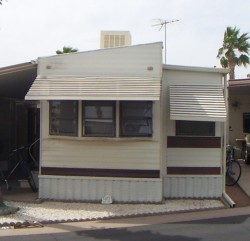 The basic unit is 8 feet but
there are sections expanded
The basic unit is 8 feet but
there are sections expanded
by (usually) an additional four feet.
Some run the length
of the trailer and some less.
The unit shown here is an early '80s model. In the
late
'80s and early '90s the manufacturers began making
most
park models a full 12 foot wide.
The most common trailer in the parks are the standard 12 foot width
and are designed to
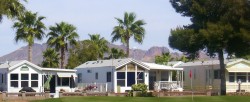
appear more like a permanent
dwelling with standard pitched
and
shingled rooflines.
Windows and doors are more like a
house and interiors also
more
house-like.
A very typical park model may be
10 to 15 years old. The
ones shown
at the left are commonplace.
Then there are the 'higher end' units that have been added to and
modified.
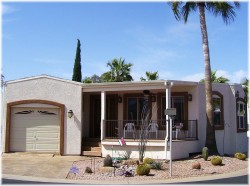
These tend to be more common in the resident-owned parks (but not
exclusively).
The owners in these parks have a much higher investment and monies
spent adding to the unit represents a far smaller percentage of the
unit total cost and possibly less risk.
A variety of modifications and additions have added a lot more
space and may even include a regular attached garage.
The end result is some pretty elaborate set-ups for what began as a
400 square foot park model.
Front Living Area
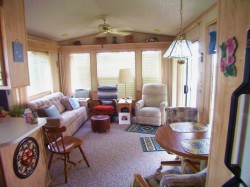
Probably more than half of the space is the front living,
dining, kitchen area.
The open design adds both spaciousness and versitility. It is a
very practical layout.
Most units have ample windows and combined with the front entry
patio doors they are very bright and open.
Kitchen
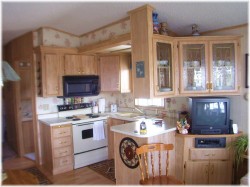
The kitchen setup makes
good use of
space and generally there is ample cupboard space.
Most
units also have some type of china cupboard and extra storage.
The appliances are pretty well what you will have at home with
possibly one exception. Propane is fairly common for cooking and
heating.
Dining
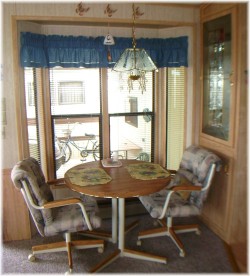
The dining area is usually set up for two or four people. There is
often a second china cupboard and possibly additional storage in this
area.
The dining area can be quite small but is really all that most
need. Most units are only occupied by two people and most of the
entertaining is done outdoors in the patio area or Arizona room.
Bathroom
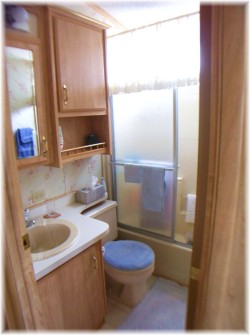
Bathrooms are pretty standard four piece. Usually
quite small, at least compared to todays large facilities in many
homes. But they have come a long way from those tiny old travel
trailer bathrooms.
They are certainly very functional and are getting a bit larger in
newer units. They also have pretty reasonable storage space.
Bedroom
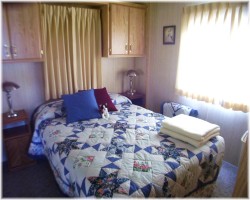
Bedrooms tend to have quite a bit of closet and other storage
space. Usually one wall is dedicated to double closets and drawers.
The standard bedroom is probably in the range of 110 to 120 square
feet. They are quite adequate. Although a king bed may be a tight fit.
The Outside Living Space
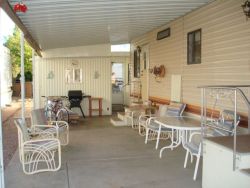
Nearly all the park models sit on a lot that provides anywhere from
about 15 to 25 feet of side yard. Normally that side yard is
covered 'patio style' and serves outdoor living and vehicle parking.
Some parks have deeper narrower lots allowing parking in the front
while others are wider and allow parking at the side.
The climate is so conducive to outdoor life that the patio area
can become like an added living room. It is possibly the most
common area used for entertaining and maybe even regular dining. (No
bugs remember)
The Storage Shed - More living
space
An important part of the trailer unit. When you consider the
limitations on trailer size the storage shed becomes far more
valuable than your old shed in the back yard at home.
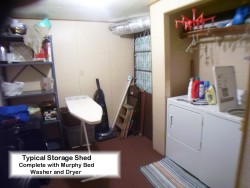
A storage shed is common fare and they are usually about 8X10 feet
or larger. They are extremely valuable, especially when you consider
you have no basement and the trailer size is limited. In fact I don't
know what you would do without one.
The storage shed is rarely just a place for storage. Of course they
are used for storage but the creative uses are pretty wide
ranging. They are a natural location for a workbench and a common
use as a place for your own washer and dryer.
But sometimes larger sheds are almost used as extra living quarters
... TV or computer rooms and even the odd one with a mattress for
extra visitors. Although probably against some rules they do tend
to serve in an emergency.
The Arizona Room - Even more living
space
Many people add a room at the side of the trailer to provide some
extra living space. These rooms are known as 'Arizona Rooms'. They are
constructed in varying sizes over part or even all of the side or
patio area. (Apparently in Florida they are known as a 'Florida
Room')
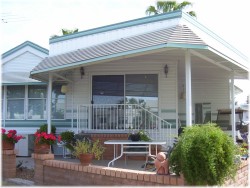 There are many different designs
and
There are many different designs
and
layouts, some quite basic and others much
more elaborate.
They serve a variety of purposes including
space for guests with
some even adding extra
bathroom facilities.
But probably the most common is for the
Arizona room to serve
as a type of 'family
room' ... similar to the one in
your house
back home.
Extra Room for Guests
It seems every trailer has a sofa bed (or whatever they are
called in your area) to accomodate extra guests. They are pretty well
standard fare in the living room. And just as common in the Arizona
Room.
In addition, some storage sheds will have means to accomodate
guests sleeping quarters with a Murphy Bed or some other
arrangement.
Visitors are common in the parks and it is easy to tell when
it is 'spring break' or (naturally) Christmas and other holidays. The
kids and grandkids come to visit. And of course friends from 'back up
north' will visit to experience some winter getaway.
The Vegetation
Most parks have a variety of plants and some lots may have small
growing spaces. And of course there are the Citrus Trees, Palm Trees,
and the Cactus.

Breakfast in the Back Yard?
The citrus trees are commonplace throughout the parks.
It is quite common for a park model lot to have mature
grapefruit and orange trees. They are a very special treat for
us northerners who can't imagine going out in the morning and picking
off some grapefruit and oranges
for breakfast. But that is
pretty normal for many park residents.
Palm Trees - the unofficial
emblem of RV Resort Parks

And of course a symbol of the south to us northerners are the
palm
trees, a common site in the parks.
They epitomize a warm holiday place for those of us who only see
them in pictures. And that is probably why they are used as an
attraction for the northerners.
If you can't find the park just look over the landscape for a
collection of
Palm Trees and that may be it.
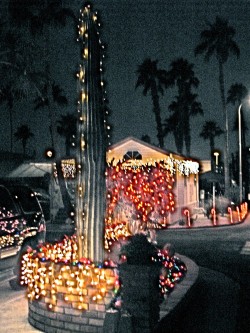
Cactus
And the cactus is also a symbol.
It is a symbol of the desert. There are many varieties, some only
found in desert locations. They are a common fixture on RV lots.
There are wonderful cactus blooms in the spring and they certainly
add to the flavor of the desert location.
The larger cacti often take on the role of Christmas trees
when that season roles around. (The picture on the right was taken
last Christmas in an RV Park in Apache Junction.)
Checking Park
Model Condition
- Age
- Roofs
- Floors
- Wiring
- Plumbing
- Termites
- Heating
- Air Conditioning
- Swamp Coolers
The condition of the units will of course vary widely. Older units
can have some real serious problems. They are generally not
constructed to the same standards as most houses so judging the
expected condition of the unit by age is different than for the
typical house. (A twenty year-old park model is viewed
as much older than a 20 year-old house ... also see watch out for the rules
section about impacts of park model age.)
A couple key items to look for are the condition of the roof
and the floor. Roofs are most vulnerable. They can
certainly be prone to leaks and weakened by previous water damage.
Older park models came with metal roofs and a
common site is an old roof with patches over patches.
Newer units have traditional shingled roofs and are really not
much different than your normal house roof.
Floors can become weakened from previous water or termite
damage. What seems like a simple floor squeak can be a sign of
bigger problems. It is a good idea to have a look underneath to
see the condition of the floor.
Electrical wiring can be somewhat less than up to normal
household standards as well. Again, this can be more of an issue in
older park models where modifications may have been made
over the years.
Plumbing is often done using plastic water lines and over
time some of this older plastic becomes hardened and can easily break,
especially at or near joints. Plumbing is usually not that hard to
access and lines can be repaired and even (quite easily) updated.
Another common issue in the Phoenix area is the termites.
They can really wreak havoc with a trailer. They are common and if the
owner hasn't done proper prevention they can infest the trailer.
If you are not familiar with what to look for it may be a good
investment to have an inspection by a pest control company.
Heating equipment is similar to a regular house with the possible
exception of the common use of propane in the older units. Many
of those are equipped with propane for both heating and cooking.








 A huge huge advantage
of having a winter residence in the (larger) parks is the 24 hour
security. These parks are gated and most have a security person at
the gate checking who comes into the park.
A huge huge advantage
of having a winter residence in the (larger) parks is the 24 hour
security. These parks are gated and most have a security person at
the gate checking who comes into the park. 

 The basic unit is 8 feet but
there are sections expanded
The basic unit is 8 feet but
there are sections expanded 


 The kitchen setup makes good use of
space and generally there is ample cupboard space.
The kitchen setup makes good use of
space and generally there is ample cupboard space.




 There are many different designs
and
There are many different designs
and

